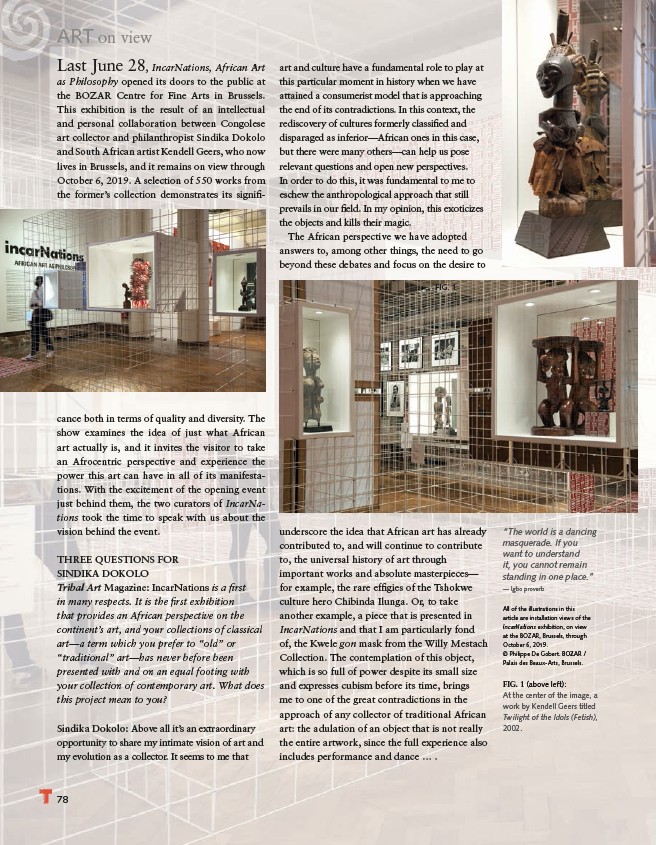
art and culture have a fundamental role to play at
this particular moment in history when we have
attained a consumerist model that is approaching
the end of its contradictions. In this context, the
rediscovery of cultures formerly classifi ed and
disparaged as inferior—African ones in this case,
but there were many others—can help us pose
relevant questions and open new perspectives.
In order to do this, it was fundamental to me to
eschew the anthropological approach that still
prevails in our fi eld. In my opinion, this exoticizes
the objects and kills their magic.
The African perspective we have adopted
answers to, among other things, the need to go
beyond these debates and focus on the desire to
FIG. 1
78
underscore the idea that African art has already
contributed to, and will continue to contribute
to, the universal history of art through
important works and absolute masterpieces—
for example, the rare effi gies of the Tshokwe
culture hero Chibinda Ilunga. Or, to take
another example, a piece that is presented in
IncarNations and that I am particularly fond
of, the Kwele gon mask from the Willy Mestach
Collection. The contemplation of this object,
which is so full of power despite its small size
and expresses cubism before its time, brings
me to one of the great contradictions in the
approach of any collector of traditional African
art: the adulation of an object that is not really
the entire artwork, since the full experience also
includes performance and dance … .
“The world is a dancing
masquerade. If you
want to understand
it, you cannot remain
standing in one place.”
— Igbo proverb
All of the illustrations in this
article are installation views of the
IncarNations exhibition, on view
at the BOZAR, Brussels, through
October 6, 2019.
© Philippe De Gobert. BOZAR /
Palais des Beaux-Arts, Brussels.
FIG. 1 (above left):
At the center of the image, a
work by Kendell Geers titled
Twilight of the Idols (Fetish),
2002.
ART on view
Last June 28, IncarNations, African Art
as Philosophy opened its doors to the public at
the BOZAR Centre for Fine Arts in Brussels.
This exhibition is the result of an intellectual
and personal collaboration between Congolese
art collector and philanthropist Sindika Dokolo
and South African artist Kendell Geers, who now
lives in Brussels, and it remains on view through
October 6, 2019. A selection of 550 works from
the former’s collection demonstrates its signifi -
cance both in terms of quality and diversity. The
show examines the idea of just what African
art actually is, and it invites the visitor to take
an Afrocentric perspective and experience the
power this art can have in all of its manifestations.
With the excitement of the opening event
just behind them, the two curators of IncarNations
took the time to speak with us about the
vision behind the event.
THREE QUESTIONS FOR
SINDIKA DOKOLO
Tribal Art Magazine: IncarNations is a fi rst
in many respects. It is the fi rst exhibition
that provides an African perspective on the
continent’s art, and your collections of classical
art—a term which you prefer to “old” or
“traditional” art—has never before been
presented with and on an equal footing with
your collection of contemporary art. What does
this project mean to you?
Sindika Dokolo: Above all it’s an extraordinary
opportunity to share my intimate vision of art and
my evolution as a collector. It seems to me that